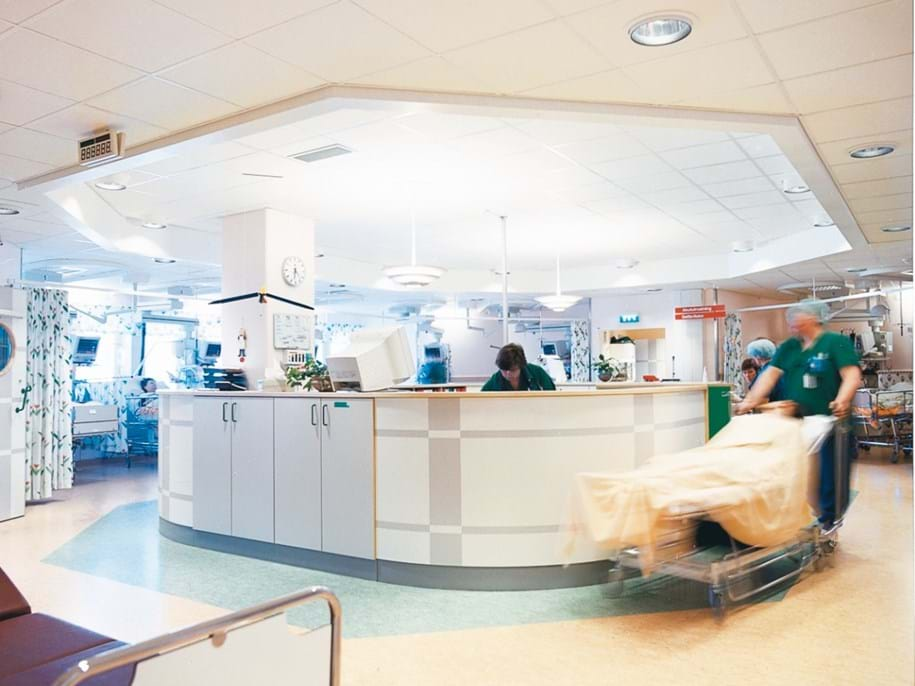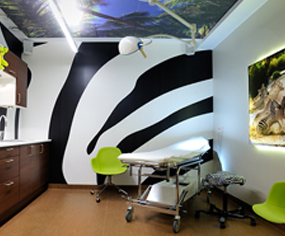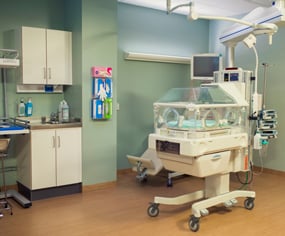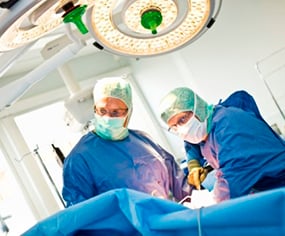
Five tips for reducing noise levels in hospitals
Members of staff devote about 40 per cent of their work time to various forms of communication. In order to make them more accessible, give them a better overview and bring them closer to the patients, many hospital employees work in open-plan environments. This might be in emergency or intensive care departments or nurses’ stations located in or at the intersection of corridors.
Within this space, staff are expected to hear and interpret alarms, conduct confidential conversations, carry out their rounds and, in many cases, undertake complex medical tasks. A suboptimal acoustic environment increases the risk of miscommunication and hence errors, as well as contributing to unnecessarily high stress levels that take their toll on the staff.
Loud equipment noises, alarm sounds and voices all disturb healing sleep and cause stress to patients. Patients in emergency departments, intensive care units (ICU), and operating theatres, and newborn babies in neonatal units, are especially sensitive to disturbing sounds. Average noise levels of up to 70 dB have been recorded inside incubators in neonatal units. Premature babies are at greatly increased risk of permanent hearing damage.
How to improve the sound environment in hospitals:
 Room design imitating nature
Room design imitating nature
 Our hearing has evolved so that it works best outdoors in the natural world. The objective is therefore to try to imitate nature’s acoustic environment inside hospitals. In the natural world we seldom find straight, parallel surfaces that reflect sound waves back and forth across a space, producing disturbing responses.
Our hearing has evolved so that it works best outdoors in the natural world. The objective is therefore to try to imitate nature’s acoustic environment inside hospitals. In the natural world we seldom find straight, parallel surfaces that reflect sound waves back and forth across a space, producing disturbing responses.
Consider the fact that long corridors designed only with reflective surfaces will carry sound over longer distances, increasing noise levels in general. Irregular spatial design is therefore preferable where possible. Irregular or convex-shaped reception desks could be a solution, as these distribute the sound waves in different directions.
Sound-absorbent cleanable wall panels may be used to absorb noise from the nurses’ station and corridors, reducing the overall noise level within the space. Printed with appropriate motifs, such as serene images of nature, these can also help promote a sense of calm and security.

 Reduce equipment noise
Reduce equipment noise
High noise levels in the vicinity of patients are a constant problem in ICU. Identify any sources of excess noise, such as food trolleys, automatic door openers, telephones, beds, alarms and pagers. The stand holding all the intravenous equipment is often the source of various alarm sounds.
Although it is essential that certain alarms are heard above the background noise, it is nevertheless possible to set requirements regarding noise levels when purchasing equipment. Could the alarm sound gradually increase in volume? Alarm systems that do not employ audible signals are also available.
 Increase distance between patient and noise source
Increase distance between patient and noise source
 Consider increasing the distance between noisy pieces of equipment and the patient’s ears. Our hearing is never turned off, and our brains constantly process sound signals. Tearing open a sterile package can create a noise measuring 70 dB, so avoid doing so near the patient’s head. Step away towards the foot of the bed if possible.
Consider increasing the distance between noisy pieces of equipment and the patient’s ears. Our hearing is never turned off, and our brains constantly process sound signals. Tearing open a sterile package can create a noise measuring 70 dB, so avoid doing so near the patient’s head. Step away towards the foot of the bed if possible.
 Screens between patients
Screens between patients
Overhearing other patients’ conversations, the sound of snoring and patients being in pain are examples of noise that can be discomfiting. This is one of the less pleasant memories many people are left with after being in hospital. The use of suitable, movable sound-absorbent screens between patients, perhaps with a glazed upper section, so that staff do not lose sight of other patients, could help.
 Ceilings and wall absorbers that meet hygiene standards
Ceilings and wall absorbers that meet hygiene standards
 Operating theatres can be a noisy environment, especially during orthopaedic procedures when surgeons use drills and saws. Meanwhile, clear communication is absolutely essential to a successful operation.
Operating theatres can be a noisy environment, especially during orthopaedic procedures when surgeons use drills and saws. Meanwhile, clear communication is absolutely essential to a successful operation.
Operating theatres often have bare, easily washable floors, walls and ceilings made from hard materials, which contribute to high noise levels and prolonged reverberation.
However washable, disinfectable sound-absorbent ceilings and wall absorbers are available that often meet all necessary hygiene standards.
Photos: J-P Christianson, Anders Kämpe, Elin Ohlson, Cathy Yeulet, Patrik Leonardsson.
